
The Tasmanian temperate rain forests are a temperate broadleaf and mixed forests ecoregion in western Tasmania. The ecoregion is part of the Australasian realm, which includes Tasmania and Australia, New Zealand, New Guinea, New Caledonia, and adjacent islands.

Diselma archeri is a species of plant of the family Cupressaceae and the sole species in the genus Diselma. It is endemic to the alpine regions of Tasmania's southwest and Central Highlands, on the western coast ranges and Lake St. Clair. It is a monotypic genus restricted to high altitude rainforest and moist alpine heathland. Its distribution mirrors very closely that of other endemic Tasmanian conifers Microcachrys tetragona and Pherosphaera hookeriana.

Bellendena montana, commonly known as mountain rocket, is a species of low-growing multi-stemmed shrub in the plant family Proteaceae. It is endemic to high-altitude subalpine and alpine regions in Tasmania, Australia. The prominent white flower spikes appear over summer, followed by small bright red or yellow fruit in late summer and autumn.

Richea is a genus of 11 species of flowering plants in the family Ericaceae. Nine of the species are endemic to Tasmania and the other two are endemic to the south-east of the Australian mainland.

Richea pandanifolia, the pandani or giant grass tree, is a distinctive endemic Tasmanian angiosperm. It is dicot of the family Ericaceae and is found in central, western and south west Tasmania. It is a favourite among hikers and nature lovers.

Telopea truncata, commonly known as the Tasmanian waratah, is a plant in the family Proteaceae. It is endemic to Tasmania where it is found on moist acidic soils at altitudes of 600 to 1200 m (2000–4000 ft). Telopea truncata is a component of alpine eucalypt forest, rainforest and scrub communities. It grows as a multistemmed shrub to a height of 3 metres (10 ft), or occasionally as a small tree to 10 m (35 ft) high, with red flower heads, known as inflorescences, appearing over the Tasmanian summer and bearing 10 to 35 individual flowers. Yellow-flowered forms are occasionally seen, but do not form a population distinct from the rest of the species.
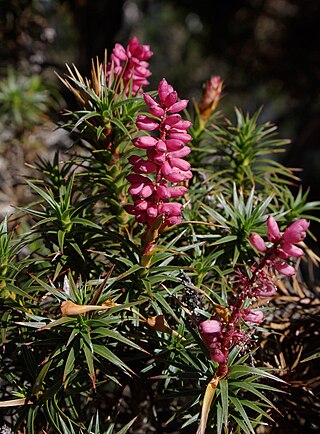
Richea scoparia is a species of plant endemic to Tasmania. The genus Richea, forms part of the Ericaceae family, which are commonly heath-like shrubs. The name refers to the erect bushy growth habit, described as a broom-like shrub, most commonly referred to as the honey bush or simply scoparia to many bushwalkers.

Dracophyllum milliganii is a species of angiosperm in the family Ericaceae and the sub-family Epacridoideae. It is a distinctive alpine shrub, endemic to western Tasmania.

Persoonia muelleri, commonly known as Mueller’s geebung, is a shrub endemic to Tasmania. It forms a shrub in open areas of wet forests in the west and northeast of the state. It is occasionally confused with P. gunnii though it has larger flowers and longer, straighter leaves.
Persoonia moscalii, commonly known as the creeping geebung, is a shrub native to southwestern Tasmania.
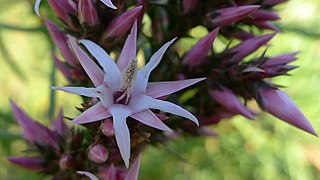
Sprengelia incarnata, commonly referred to as pink swamp-heath, is a species of flowering plant of the family Ericaceae, and is native to south-eastern Australia and New Zealand. It is an erect, glabrous shrub with sharply-pointed, stem-clasping, egg-shaped leaves, and clusters of pink, tube-shaped flowers with spreading lobes.

Orites revolutus , also known as narrow-leaf orites, is a Tasmanian endemic plant species in the family Proteaceae. Scottish botanist Robert Brown formally described the species in Transactions of the Linnean Society of London in 1810 from a specimen collected at Lake St Clair. Abundant in alpine and subalpine heath, it is a small to medium shrub 0.5 to 1.5 m tall, with relatively small, blunt leaves with strongly revolute margins. The white flowers grow on terminal spikes during summer. Being proteaceaous, O. revolutus is likely to provide a substantial food source for nectivorous animal species within its range.

Cenarrhenes is a monytypic genus in the family Proteaceae containing the single species Cenarrhenes nitida, known as the Port Arthur plum or native plum. Cenarrhenes nitida is an evergreen shrub to small tree endemic to the rainforests and scrublands of western Tasmania. It bears white flowers in late spring followed by the development of fleshy fruit.
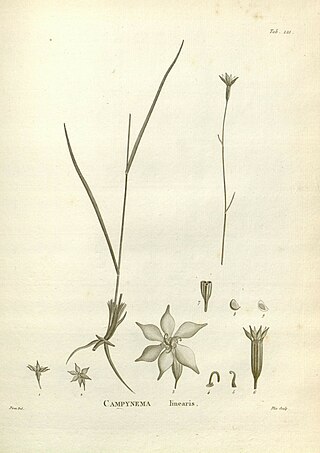
Campynema is a genus in the family Campynemataceae first described in 1805. It contains only one known species (monotypic), Campynema lineare, endemic to the island of Tasmania in Australia. Its closest relative is Campynemanthe, endemic to New Caledonia, sole other genus of the family.
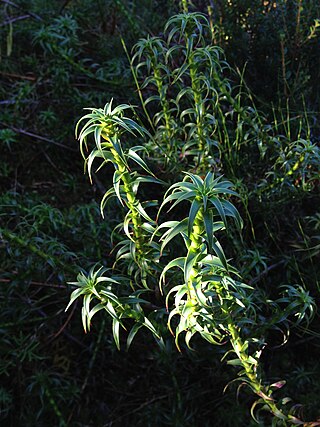
Richea gunnii, the bog candleheath or Gunns richea, is an endemic Tasmanian angiosperm. It is a dicot of the family Ericaceae and is found in Central, Western and North-east Tasmania.
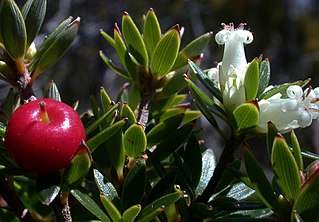
Cyathodes straminea, also known as false-whorled cheeseberry, is a species of flowering plant in the family Ericaceae endemic to Tasmania, where it grows as an alpine to subalpine shrub with a spreading habit. The generic name Cyathodes was derived from Greek "Cyath" = cup and "odes" = like, referring to the ovary encircled by cup-shaped nectary.

Orites acicularis, commonly known as yellow bush, is an angiosperm endemic to Tasmania, Australia and is a member of the genus Orites within the family Proteaceae. The species was first described in 1810 by Scottish botanist Robert Brown in Transactions of the Linnean Society of London.

Richea procera, the lowland richea, is a plant in the family Ericaceae, endemic to Tasmania, Australia. It is found in lowland areas of Tasmania with unusually small leaves for the genus Richea. Its leaves are parallel veined, from 10 to 335 mm long, 10 mm wide at the base. It is similar in appearance to the high altitude species Richea sprengelioides.
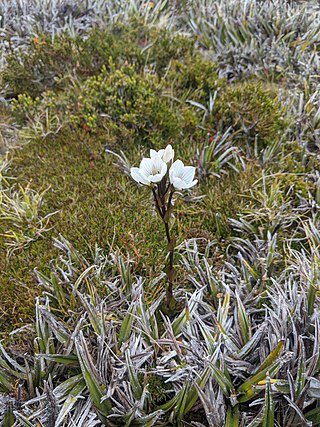
Chionogentias diemensis is a flowering herbaceous alpine plant in the family Gentianaceae, endemic to the island of Tasmania in Australia. It is commonly known as the Tasmanian mountain gentian. Chionogentias diemensis has been classified into two sub-species: the Tasmanian snow-gentian and the Ben Lomond snow-gentian.

Dracophyllum muscoides, commonly known as cushion inaka, is a small cushion plant in the family Ericaceae. It is endemic to New Zealand and is found only in the South Island in sub-alpine regions.





















